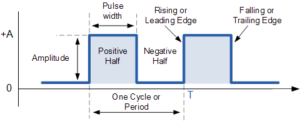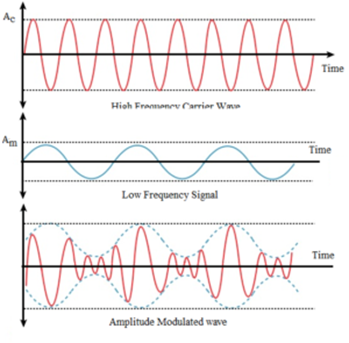Science > Physics > Communication > Modulation
Before the concept of the modulation, the signal used to be sent in form continuous wave with periodic interruption as in morse code. To code, send and decode such message high expertise was required. The direct current is not suitable for transmitting the data because of its steady nature. A continuous AC wave cannot be used for transferring data as all the variations or cycles are alike. Thus continuous AC wave in the form of a series of pulses can be used to carry data effectively.
A high-frequency carrier wave is used to carry the audio signal. The audio signal is superimposed over the carrier wave. This process is called modulation.
Modulation may be defined as the process of changing some characteristics like amplitude, frequency or phase of a carrier wave in accordance with the intensity of the signal is known as modulation.
The Need for Modulation in Communication System:
The purpose of a communication system is to transmit information or message signals. Message signals are also called baseband signals, which essentially designate the band of frequencies representing the original signal, as delivered by the source of information. No signal, in general, is a single frequency sinusoid, but it spreads over a range of frequencies called the signal bandwidth.
To understand the need for modulation let us suppose that we wish to transmit an electronic signal in the audio frequency (AF) range (baseband signal frequency less than 20 kHz) over a long distance directly. Let us find what factors prevent us from doing so and how we overcome these factors.
Size of the Antenna or Aerial:
For transmitting signals antenna is required whose length should be at least (λ/4), to sense the time variation of the signal.
c = υλ
∴ λ = c/υ
Length of antenna = λ/4 = c/4υ = 3 x 108 / (4 x 20 x 103) = 3.75 x 103 m = 3.75 km
The antenna size for considered baseband signal frequency is of impracticable length. Hence direct transmission at baseband signal frequency is not practical. If we used a frequency say 1MHz, then
Length of antenna = λ/4 = c/4υ = 3 x 108 / (4 x 1 x 106) = 75 m
This is a practical length of the antenna.
Thus we can obtain transmission by use of practical antenna length using high frequency for transmission. Thus there is a need for translating the original low-frequency signals into high frequency before transmission.
Effective Power Radiated by Antenna:
The power radiated is proportional to (l /λ)2. Where ‘l’ is the size of the antenna. Thus for the same antenna, the power radiated is inversely proportional to the wavelength of the wave i.e. directly proportional to the frequency of the wave. Thus the effective power radiated by long-wavelength is small.
For good transmission of signal high power is required. Hence direct transmission at baseband signal frequency is not practical. To get more power radiated the high-frequency transmission should be used.
Mixing Up of Signals From Different Transmitters:
For considered baseband frequency there are full chances of mixing up of the signals from the transmitters operating in the same band. It is just like many people talking simultaneously. Thus, all these signals will get mixed up and there is no simple way to distinguish between them. Hence bands are allotted to different types of broadcast and communication systems.
Operating range:
The energy of a wave is directly proportional to the frequency of the wave. For the wave to be propagated over a large distance, the wave should possess more energy. It is only possible using a higher frequency for transmission of the wave.
Wireless Communication:
Wireless communication requires propagation of waves through the atmosphere without wires. The transmission of the wave at audio frequency becomes impractical because its efficiency of radiation is poor. Thus the transmission should be done at a higher frequency for obtaining higher radiation efficiency.
Types of Carrier Waves:
There is a need for translating the original low-frequency baseband message or information signal into the high-frequency wave before transmission such that the translated signal continues to possess the information contained in the original signal. In doing so, we take the help of a high-frequency signal, known as the carrier wave, and a process known as modulation which attaches information to it. The carrier wave may be continuous (sinusoidal) or in the form of pulses.
Continuous or Sinusoidal wave:

Pulse:

Types of Modulation w.r.t. Continuous (sinusoidal) Wave as Carrier Wave:
A sinusoidal carrier wave can be represented as
c(t ) = Ac sin (ωt +Φ)
where c(t) is the signal strength (voltage or current), Ac is the amplitude,
ω = 2πfc = the angular frequency and
Φ is the initial phase of the carrier wave.
During the process of modulation, any of the three parameters, viz amplitude Ac, angular frequency ω, and the phase Φ, of the carrier wave can be varied with baseband signal or message or information signal. This results in three types of modulation.
- Amplitude modulation (AM): In this type of modulation, angular frequency ω and the phase Φ are kept constant and amplitude Ac of the carrier wave is varied in accordance with the modulating wave.
- Frequency modulation (FM): In this type of modulation, amplitude Ac and the phase Φ are kept constant and angular frequency ω of the carrier wave is varied in accordance with the modulating
- Phase modulation (PM): In this type of modulation, amplitude Ac and angular frequency ω are kept constant and the phase Φ of the carrier wave is varied in accordance with the modulating
Note that the frequency modulation and phase modulation of a carrier wave is collectively called the angle modulation. Analog communication of analog signals is done using continuous wave.
Types of Modulation w.r.t. Pulse as Carrier Wave:
The significant characteristics of a pulse are pulse amplitude, pulse duration or pulse width, and pulse position (denoting the time of the rise or the fall of the pulse amplitude. Hence, different types of pulse modulation are:
- pulse amplitude modulation (PAM),
- pulse duration modulation (PDM) or pulse width modulation (PWM), and
- pulse position modulation (PPM)
Previous Topic: Construction Working and Fabrication of Optical Fibre
Next Topic: Amplitude Modulation
